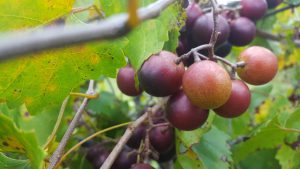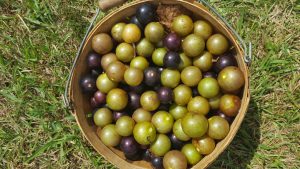
For me, there are three essential components to a Georgia summer: peach ice cream, cicadas singing in the pine trees, and of course, muscadines. It’s hard to imagine being outdoors in the heat and not seeing at least one wild vine or some muscadine jelly at a local farmers market. The vines that bear these tangy treats (Vitis rotundiflora) are very closely related to other table and wine grape species (Vitis vinifera, etc). Not only are these bronze and black treats great to eat by themselves, but they make fantastic jellies, sauces, ciders, and of course, wine.
While many would say muscadines are much easier to care for than their European cousins, that doesn’t mean you can plant them, leave them to their own devices, and expect to get fruit off of them year after year. Step one to planting any vine is to decide on the type of trellis you will need. Muscadines can be grown on either one wire or double curtain trellises, both of which are about five feet high. These trellising systems ensure air flow, provide structural support, and allow the maximum amount of light exposure to the canopy (for diagrams, see the link to our Home Garden Muscadine publication below).
Step two is to choose where you will place your trellis and plant your muscadines. You’ll hear me say this time and time again, but it never gets old: choose the right plant for the right spot! Muscadines hate to have wet feet, so if you plant them on a floodplain or in an area with poor drainage, you will almost certainly have issues with disease, production and overall vigor. Plant them in full sun in well drained soil, after you’ve done your soil test and prepped everything accordingly, of course!
Step three: plant and develop! Plant your vines with plenty of space in between, and make sure they are trained to reach up to the trellis. As the vine grows, make sure to pinch off any additional growth from the main stem. This will just take away nutrients from the rest of the plant, and you want to make sure it grows up to grab that trellis. It takes two to three years to see fruit on your muscadine vines, so the care you give your plants in the first couple of years is essential! Once the stem has reached the horizontal wire of the trellis, pinch off the tip and train the shoots that grow from that point to the wires.
Step four is one that most people tend to skip but is still just as important as the rest: maintenance. As I’m sure you’ve seen walking through the woods, or even looking at your grandmother’s 40 year old vines, muscadines can completely take over if they’re not pruned back. Every year, prune the last year’s growth back to 3 buds (about 2-3 inches). This will keep your vine under control, reduce disease, and promote fruit production!
Muscadines are often much easier to grow than table or wine grapes because of their resistance to numerous diseases found in Georgia. According to UGA Extension Plant Pathologist Dr. Phil Brannen, “As compared to vinifera wine grapes, muscadines do not get downy mildew, and they are much more tolerant of powdery mildew. Muscadines will get quite a few fruit rots… but rots are generally less aggressive in muscadines than vinifera and French-American hybrids.”
Dr. Brannen also recommends planting specific tried and true varieties. ” ‘Carlos’ (bronze variety) and ‘Noble’ (black variety) are among the most often planted varieties in the Southeast as a whole. Other major varieties include ‘Magnolia’, ‘Fry’, ‘Higgins’, and ‘Cowart’, but there are quite a few minor varietal possibilities as well. Muscadine varieties differ in disease susceptibility. For example, Carlos is much more susceptible to most diseases than Noble; though a fungicidal spray program is recommended for Noble, a good program is much more important for Carlos.”
For more information, check out our “Home Garden Muscadines” publication here. If you follow these simple yet important steps when planting your own muscadines, in two to three years you can have your very own crop of these summer sweets to help you beat that Georgia heat!
